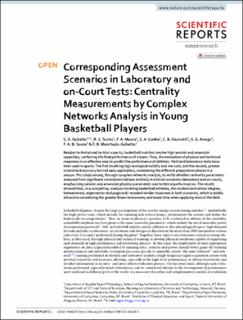| dc.contributor.author | Gobatto, Claudio | |
| dc.contributor.author | Torres, Ricardo Da Silva | |
| dc.contributor.author | Moura, Felipe | |
| dc.contributor.author | Cunha, Sergio | |
| dc.contributor.author | Giacometti, Caio | |
| dc.contributor.author | Araujo, Gustavo | |
| dc.contributor.author | Sousa, Filipe | |
| dc.contributor.author | Manchado-Gobatto, Fúlvia | |
| dc.date.accessioned | 2020-08-19T11:27:30Z | |
| dc.date.available | 2020-08-19T11:27:30Z | |
| dc.date.created | 2020-07-27T15:33:05Z | |
| dc.date.issued | 2020 | |
| dc.identifier.citation | Scientific Reports. 2020, 10 (8620), . | en_US |
| dc.identifier.issn | 2045-2322 | |
| dc.identifier.uri | https://hdl.handle.net/11250/2672999 | |
| dc.description.abstract | Besides technical and tactical aspects, basketball matches involve high aerobic and anaerobic capacities, conferring the final performance of a team. Thus, the evaluation of physical and technical responses is an effective way to predict the performance of athletes. Field and laboratory tests have been used in sports. The first involving high ecological validity and low cost, and the second, greater control and accuracy but not easy application, considering the different preparation phases in a season. This study aimed, through complex networks analysis, to verify whether centrality parameters analysed from significant correlations behave similarly in distinct scenarios (laboratory and on-court), emphasizing aerobic and anaerobic physical parameters and technical performances. The results showed that, in a compelling analysis involving basketball athletes, the studied centralities (degree, betweenness, eigenvector and pagerank) revealed similar responses in both scenarios, which is widely attractive considering the greater financial economy and lower time when applying tests in the field. | en_US |
| dc.language.iso | eng | en_US |
| dc.publisher | Nature Research | en_US |
| dc.rights | Navngivelse 4.0 Internasjonal | * |
| dc.rights.uri | http://creativecommons.org/licenses/by/4.0/deed.no | * |
| dc.title | Corresponding Assessment Scenarios in Laboratory and On-Court Tests: Centrality Measurements by Complex Networks Analysis in Young Basketball Players | en_US |
| dc.type | Peer reviewed | en_US |
| dc.type | Journal article | en_US |
| dc.description.version | publishedVersion | en_US |
| dc.source.pagenumber | 10 | en_US |
| dc.source.volume | 10 | en_US |
| dc.source.journal | Scientific Reports | en_US |
| dc.source.issue | 8620 | en_US |
| dc.identifier.doi | 10.1038/s41598-020-65420-3 | |
| dc.identifier.cristin | 1820656 | |
| dc.description.localcode | Open Access This article is licensed under a Creative Commons Attribution 4.0 International License, which permits use, sharing, adaptation, distribution and reproduction in any medium or format, as long as you give appropriate credit to the original author(s) and the source, provide a link to the Creative Commons license, and indicate if changes were made. The images or other third party material in this article are included in the article’s Creative Commons license, unless indicated otherwise in a credit line to the material. If material is not included in the article’s Creative Commons license and your intended use is not permitted by statutory regulation or exceeds the permitted use, you will need to obtain permission directly from the copyright holder. To view a copy of this license, visit http://creativecommons.org/licenses/by/4.0/. | en_US |
| cristin.ispublished | true | |
| cristin.fulltext | original | |
| cristin.qualitycode | 1 | |

